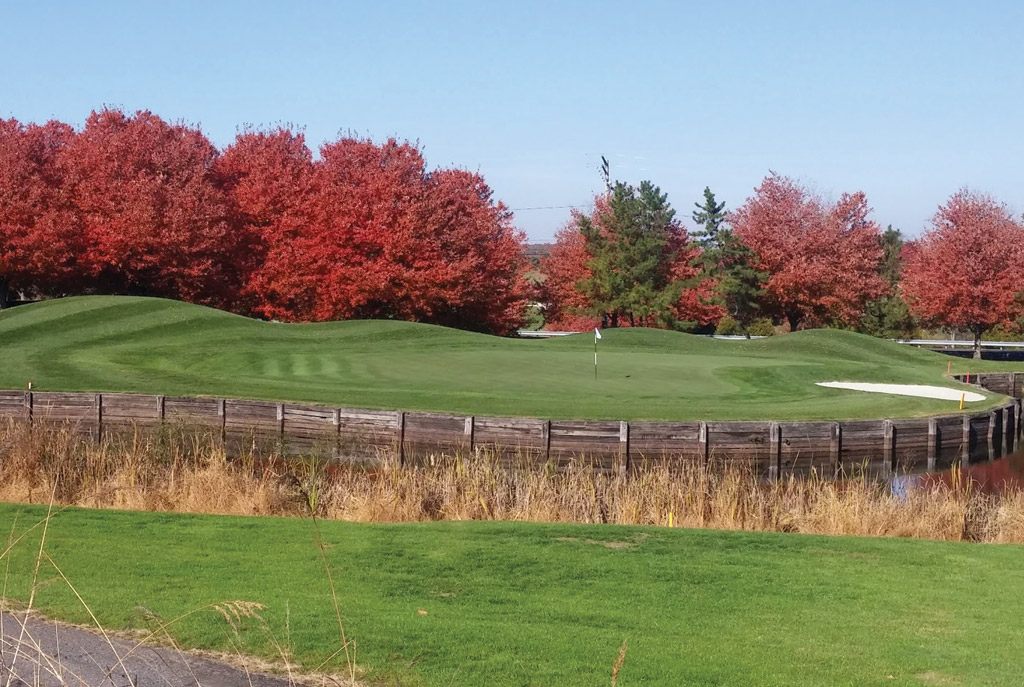[…]owners are responsible for contacting federal, state, and local water use authorities at the pre-and post-construction phases to determine annual or specific water consumption (water rights), permitting guidelines, and other regulatory requirements. Most uses of water in Maryland require a Water Appropriation Permit (WAP) from the MDE. Permitted users with withdrawals (surface water or groundwater) exceeding 10,000 gallons per day are required to report monthly withdrawals to MDE. MDE maintains a permit guide with information on water use appropriation and permits. MDE maintains the state’s official drought status. Maryland uses a four-stage approach to drought status. Superintendents should be aware […]
[…]the overseeded cool-season grass species. Best Management Practices Remove thatch to improve seed-to-soil contact as part of an active cultivation program before overseeding. Reduce or eliminate fertilization of the base grass three to four weeks before the planned seeding date to minimize growth and competition. Core-aerate the soil four to six weeks before the planned overseeding date to open turf canopy and aid in uniform establishment of overseeded grass. Select cultivars that are adapted to the desired use, taking note of disease resistance and spring transition traits. Irrigate newly planted overseed to maintain constant moisture levels, not allowing the soil […]
[…]out minor surface irregularities, aiding in the management of thatch accumulation. Use only weed-free topdressing materials with a particle size similar to that of the underlying root zone to dilute thatch. Topdressing the playing surface with sand improves surface firmness and smoothness, dilutes thatch, improves recovery from turf thinning or cultural practices, and, over time, modifies the root zone. Photo credit: Chris Harriman. Next: […]
[…]open areas to prevent erroneous readings. Use multiple soil moisture sensors/meters for accuracy and to reflect soil moisture levels. On-site weather stations access weather information and ET rates to determine site-specific water needs. Photo credit: Mark Jones. Next: Irrigation System […]
[…]by MDA. Detailed descriptions of general regulatory requirements, as well as requirements for storage, transportation, licensing, and record keeping, are provided in: Maryland Pesticide Applicator Core Manual. National Association of State Departments of Agriculture Research Foundation. Pesticide Information Leaflet No. 35: Synopsis of the Maryland Pesticide Applicators Law and Regulations. 2012. University of Maryland Extension. Next: Human Health […]
[…]as hazardous waste. In the event of a spill, contact the MDE Emergency Response Division (866-633-4686) and the National Response Center (800-424-8802) to determine if the amount constitutes a reportable quantity. Next: Storage and Handling of […]
[…]management of lakes and ponds should include a clear statement of goals and priorities to guide the development of the BMP necessary to meet those goals. Some of the challenges facing superintendents in maintaining the quality of golf course ponds are as follows: low dissolved oxygen (DO) levels sedimentation changes in plant populations nuisance vegetation maintenance of littoral shelves vegetation on the lakeshore Nutrient enrichment from nitrogen, phosphorus, and sediments in surface water runoff can increase the growth of aquatic plants, algae, and bacteria in ponds. Therefore, an important BMP is to maintain a riparian buffer around surfaces waters to […]
[…]applications to achieve a soil pH of about 6.4 are available. (See Nutrient Management Guidelines for Commercial Turfgrass Seeding. ) If diseases such as summer patch of Kentucky bluegrass or spring dead spot of bermudagrass are of concern, maintaining lower soil pH (5.4 to 5.7) may be desirable, and reduced or no limestone should be applied to achieve this level. Also, it is recommended, when practical, that limestone be applied approximately one month or more before seeding to minimize potential P availability problems and the potential for volatilization loss of applied N. While these recommendations should result in satisfactory establishment […]
[…]to third internode and seedlings have reached a height of one-third greater than intended height-of-cut. This will hasten establishment. Next: Erosion and Sediment […]
[…]equipment properly will extend useful life and reduce repairs. Best Management Practices Store and maintain equipment in a covered area complete with a sealed impervious surface. This limits risk of fluid leaks contaminating the environment and facilitates the early detection of small leaks that may require repair before causing significant damage to the turf or the environment. Seal floor drains unless they are connected to a holding tank or sanitary sewer with permission from the local wastewater treatment plant. Store pesticide and fertilizer application equipment in areas protected from rainfall. Rain can wash pesticide and fertilizer residues from the exterior of […]

